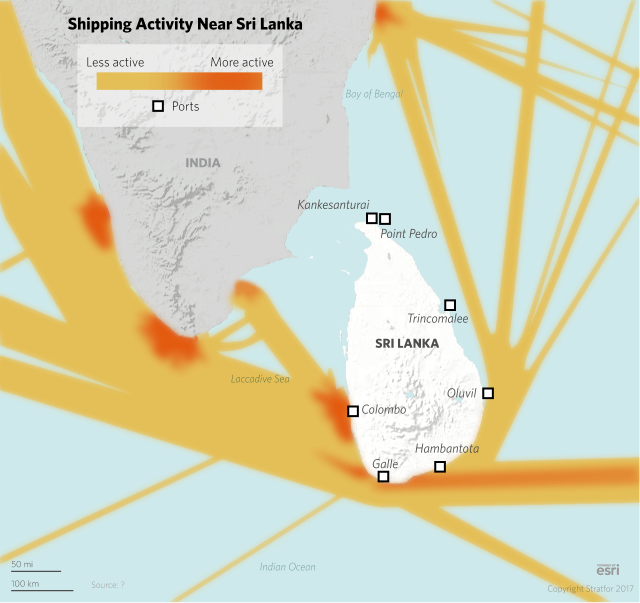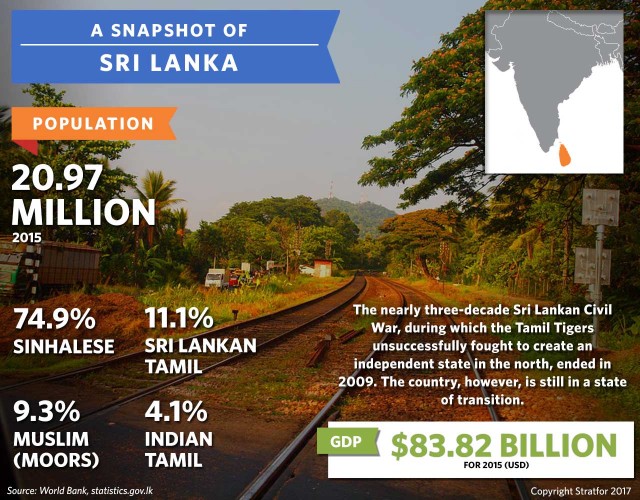Forecast
- This year will bring more political infighting in Sri Lanka as former President Mahinda Rajapaksa tries to stir discontent ahead of local elections and constitutional reform.
- The disarray will continue to cause headaches for China, which invested in strategic and lucrative development projects in the country at a more placid time.
- Tamil nationalism will further complicate matters as nostalgia for the defunct Liberation Tigers of Tamil Eelam insurgency inreases among members of the ethnic minority.
Analysis
Sri Lanka's raucous political scene is poised to become even more tumultuous in the coming year. Once notorious as the home of the Liberation Tigers of Tamil Eelam, a militant group better known as the Tamil Tigers, Sri Lanka resolved its decadeslong civil war in 2009. But in the years since the government's victory over the Tamil Tigers, the underlying tension between Sri Lanka's Buddhist ethnic Sinhalese majority (75 percent of the country's population) and the Hindu ethnic Tamil minority has persisted. Now, Tamil and Sinhalese leaders in Sri Lanka are at odds over the country's political future, complicating President Maithripala Sirisena's plans to enact constitutional reforms.
To make matters more difficult for the current administration, former President Mahinda Rajapaksa — who lost power in a 2015 electoral upset — promised in late December to "topple" Sirisena's government this year. Already, Rajapaksa has proved a formidable political foe as the leader of a movement that has forced the government in Colombo to rethink a development deal with China. Though the central government and Parliament still have a few years before the next general elections, the upheaval in Sri Lankan politics — and a round of local elections later this year — will test the sustainability of Sirisena's administration.

Despite its small size, Sri Lanka holds substantial strategic value by virtue of its geographic position: It is at the center of Asia's busiest maritime routes and has a wealth of natural deep harbors. Over the years, the country has attracted the interest of nearby India, which intervened periodically in Sri Lanka's civil war, brokering a peace deal in 1987 and dispatching troops to enforce it. The civil war also afforded China the opportunity to establish a footprint on the island nation. In 2005, when India — along with Western powers concerned with human rights issues — left Colombo to deal with the conflict on its own, Beijing stepped in and offered the Sri Lankan military $1 billion in aid. China continued to lend the country financial assistance even after the war's end, providing loans for development projects such as hydropower dams, roads and port infrastructure. Today, the Sri Lankan government owes Beijing $8 billion, more than 12 percent of its total $64.9 billion debt. Over one-third of the country's government revenue goes to servicing that debt.
An Inopportune Development
Much of the political tumult in Sri Lanka stems from China's growing influence in the country. On Jan. 8, 21 people were injured and 52 arrested after protests broke out at a ceremony marking the first brick laid at the Hambantota Industrial Zone, a 6,000-hectare (15,000-acre) industrial park near southern Sri Lanka's Hambantota port. At the same time as the Hambantota demonstration, members of the Ceylon Ports General Employees Union staged sympathy protests at the ports of Galle and Colombo. Adding further weight to the civil action, lawmakers from the Joint Opposition, a parliamentary coalition still loyal to Rajapaksa, also participated in the demonstrations. Choosing his moment carefully, the former president then called for a meeting with China's ambassador to Sri Lanka to discuss concerns about the project, an initiative Rajapaksa himself proposed while in office. Members of the opposition object to the terms of the original agreement, which offers China Merchants Port Holdings Co. Ltd. a 99-year lease on the industrial park in exchange for granting Sri Lanka $1.1 billion in debt relief. (Activists have described the project as the beginning of a "Chinese colony" on the island.) Rajapaksa, meanwhile, opposes the appropriation of local village land under the agreement, insisting that the original deal leased only about 300 hectares on a shorter term.

In the wake of the protests, the Sri Lankan government deferred signing the agreement, delegating the matter to a special parliamentary committee — much to Beijing's dismay. This is not the first time China has weathered a political firestorm sparked by its development projects in Sri Lanka. In March 2015, the $1.4 billion Colombo Port City project, which Chinese President Xi Jinping personally inaugurated six months earlier, came under criticism in Sri Lanka for appearing to grant the Chinese military potential control of the country's airspace. After repeated delays, the Sri Lankan government finally gave the go-ahead to resume construction on the project, now known as the "Financial City," in March 2016. (On Jan. 5, Prime Minister Ranil Wickremesinghe announced that Sri Lanka's air force and navy would be handling the project's security.) The Chinese government struck both deals as part of its Maritime Silk Road Initiative back when Rajapaksa had a tight hold on power. Since his defeat in 2015, the projects have become a source of growing contention between the current administration and Rajapaksa's supporters in the opposition.
The President's Predicament
The discord in Sri Lankan politics looks unlikely to abate anytime soon. Sirisena, a rival from Rajapaksa's own Sri Lanka Freedom Party, owes his surprise victory in the 2015 elections in large part to the support of minority parties. Many voters in Sri Lanka's Tamil-dominated northeastern regions pulled for the current president, likely motivated by distaste for Rajapaksa's role in the bloody assault on Tamil Tiger territory that ended the civil war — killing thousands of civilians in the process. In addition, Tamil voters objected to Rajapaksa's attempts to centralize power in Colombo. The Tamil National Alliance, a coalition of Tamil parties that picked up 16 seats in Parliament during the 2015 vote, has put greater regional autonomy at the center of its platform. If the current government does not honor its demands, Sirisena may well lose the Tamil National Alliance's backing in the next national elections.
Sri Lanka's Geographic Challenge
In fact, the coalition threatened Jan. 15 to rescind its support for the president's constitutional reforms if the government does not heed its calls for a federalist model and a merger of the country's Northern and Eastern provinces. But doing so would jeopardize Sirisena's standing among his Sinhalese supporters, who staunchly oppose granting Sri Lanka's Tamil areas more power. For Rajapaksa, Sirisena's loss would be his gain, since the former president has positioned himself as the champion of the anti-federalist cause. Though Sirisena has staked his political future on constitutional reforms to reverse Sri Lanka's "executive presidency" system and reform the electoral process, he has little room to maneuver.
Mounting Opposition
At the same time, signs of growing grassroots opposition to the central government are cropping up in Tamil areas, mostly in response to the enduring presence of Sri Lankan forces there and their continued occupation of land. (Since the civil war's conclusion, the military has returned only 5.2 percent of the private land it seized from Tamils following the conflict.) Members of the Tamil minority have even become less restrained in their expressions of nostalgia for the Tamil Tiger insurgency, long considered a taboo in the country. An official in Jaffna district caused national uproar Dec. 28 by stating that Tamil Tiger leader Velupillai Prabhakaran would have made an excellent lawmaker or president. Students in the district even dragged out Tamil Tiger memorabilia and military headstones to celebrated a Tamil holiday.
Notwithstanding the mounting turmoil in Sri Lanka, Sirisena's rule is not in any immediate danger. His National Unity government holds 155 of the 225 seats in Parliament, while the pro-Rajapaksa faction has only 50 seats. Furthermore, Parliament cannot be dissolved until mid-2019, and the next presidential election will not take place until 2020. But in the meantime, Rajapaksa and other elements of the opposition will have opportunities to resist the current administration, for instance by continuing to undermine the constitutional reform process. Some opposition politicians have even called for a referendum on the proposed amendments, and if the recent referendums in the United Kingdom, Colombia and Italy are any guide, such a vote could bode ill for the government. The opposition will continue galvanizing dissent against various development projects to stymie the government and frustrate Beijing. Later this year, local elections will shed light on the success of their efforts against Sirisena and on the president's future prospects. Upsets in these races could tip public opinion across Sri Lanka and prompt the country's leaders to reassess their alliances ahead of the national votes.
StratforLead Analyst: Evan Rees
(Stratfor)



